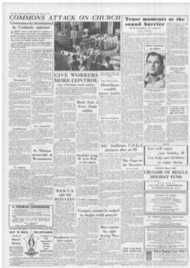Page 7, 25th July 1952
Page 7

Report an error
Noticed an error on this page?If you've noticed an error in this article please click here to report it.
Tags
Share
Related articles
Censors In The Black Books
English In The Holy See's New Directory
New Reform In Roman Curd?
Holy Office Warning
Papal Curia Meets
Holy Office renews Papal directions
CERTAIN modern forms of sacred art are ‘-'strongly criticised in an instruction which the Supreme Sacred Congregation of the Holy Office has addressed to the Bishops throughout the world.
At the same time the instruction—signed by Cardinal Pizzardo and Mgr. Ottaviani—says that Bishops should forbid numerous statues and images of little worth, and refuse permission for publications which reproduce images contrary to the mind of the Church.
Commenting on the instruction, the Vatican newspaper Osservatore RoinattO remarks that the Church's insistence on this subject is "evidently due to the fact that previous instructions have not always had the desired effect."
The Sacred Congregation recalls that in his Encyclical on the Sacred Liturgy the Holy Father said: "We cannot but deplore and press disapproval of those statues and pictures recently introduced by certain artists which seem to be a deformation and degrading of healthy art, which sometimes even openly outrage Christian dignity, modesty and piety, and which deeply offend the religious sense. We must remove them completely from our sanctuaries."
After a summary of Catholic teaching through the ages, the Sacred Congregation gives the Bishops six rules: I. ARCHITECTURE:
Sacred architecture, even if it takes new forms, cannot in any way be lumped together with secular buildings, but should always fulal its role, which is to be a house of God and of prayer.
In the construction of churches: (a) The convenience of the faithful should be taken into account so that they may be better able to take part in the services with respect and attention.
(b) The new church should also be distinguished by a fine simplicity of line, which is repugnant to decoration in had taste.
(c) But anything which might reveal a certain negligence in concept and execution should be avoided.
2. FIGURATIVE ART:
(a) According to the prescription of canon 1279: No one is permitted to put or cause to be put in churches —even those which are exempt—or in other sacred places, any unusual statue, if it has not been approved by the Bishop.
(b) The Bishop should not approve sacred etatues which are to be publicly exposed to the veneratis.. of the faithful if they do not tit the fashion (usage) approved by the Church.
(c) The Bishop shotaa never allow to be exposed in churches or other sacred places statues of a false doctrine, or statues which lack necessary decency or goodness, or which might be the occasion of dangerous error to simple paople.
(d) If there are lacking competent people on the diocesan commissions (of art), or if doubts or disputes arise, the Bishops should consult the metropolitan commissions or the Roman Commission of Sacred Art.
(e) According to the rules of canons 485 and 1178 : Bishops should take care to remove from sacred buildings anything which is in any way repugnant to the holiness of the place and to the respect which is due to God's house.
They should severely forbid numerous statues and images of little worth, mostly stereotyped, to be exposed without order or taste to the veneration of the faithful on the altars themselves or on the walls close to chapels.
(f) Bishops and reaaious superiors should refuse permission for the publication of hooks, newspapers or periodicals which reproduce images contrary to the mind and decrees of the Church.
"Bishops should taae care to include in their diocesan commission only those men who, apart from their knowledge of art, are firm adherents of the Christian faith, formed in piety, and willing to follow the directives laid down by the ecclesiastical authorities.
"In this way the Bishops will. with greater certainty, be able to ask and receive from the commission advice which cases not deviate from the rules of the Holy See and from the end of sacred art itself.
"Painting, sculpture and architecture should he confided only to men noted for their ability and who are capable of expressing a faith and sincere piety, the end of all sacred art.
"Finally, it is necessary to take care that aspirants to holy orders should. during their courses of philosophy and theology, be grounded in sacred art in a manner suited to the spirit and age of each, and that they should learn the mind of masters who respect the traditions of the ancients and obey the commeads of the Holy See."
Visible errors
C0MMENTINC on the instruction of the Holy Office, the Osservatore Romano says:
"The errors that are bewailed in the present and earlier documents are clearly visible in many poor churches. especially in the country. where shoddy statues are kept higgledy-piggledy as almost essential ornaments on the altars and walls."
"But," stresses the Osservatore. "there are also errors due to riches. as when sacred works are entrusted to artists of great renown but of insufficient religious sensibility, with the thought that a distinguished name will enable the Church's rules to be forgotten."
The Osservatore also comments on those who set their own knowledge and artistic canons against the traditions and canons of the Church, "deceiving the simple with their esoteric language and running the risk of penetrating and profaning the sanctuary with their veritable monstrosities."
blog comments powered by Disqus









